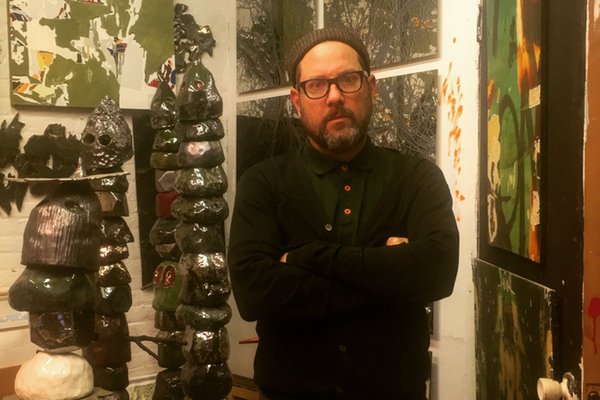Finding Sublime out of Detritus
Interview by Jennifer Nelson, WTP Feature Writer

As a sociological observer, J. Ivcevich documents the spirit of a place and highlights issues unique to the human condition in his artwork. He’s a self-taught artist who earned a sociology degree from Emory University. After college, he stayed in Atlanta working as a music producer and DJ while pursuing an art career. He was featured on the cover of New American Paintings in both the Southeast and Northeast editions. His work has appeared at the Museum of Contemporary Art of Georgia, the Jacksonville Museum of Modern Art, and the Mobile Museum of Art. He has had solo exhibitions in Indianapolis, New York, Washington, DC, Chicago, Atlanta, and Memphis. He has exhibited in group shows nationally and internationally. He received a grant from the Pollock-Krasner Foundation.
Nelson: For your Shreds series, appearing in Vol. VI #1, you photographed shredded subway posters from New York City and other places. What was the impetus for this to evolve into a series?
Ivcevich: I had already been making work focused on observations of unique urban settings and detritus but was beginning to feel like I was painting myself into a corner in some ways. I instantly recognized the random and inadvertent compositions of the torn posters. I’m not even sure when I started collecting photos but realized the infinite potential of this imagery. I travel a lot and end up gathering source material photos all over the world. It was also quite liberating in the actual process of making the work. There’s a lot of manipulation and editing while composing the finished work in both software stages and the actual painting process. It feels like a collaboration between myself and the random elements that create the shredded posters. The various series of works keep evolving in multiple ways that keep the whole process fresh and exciting.
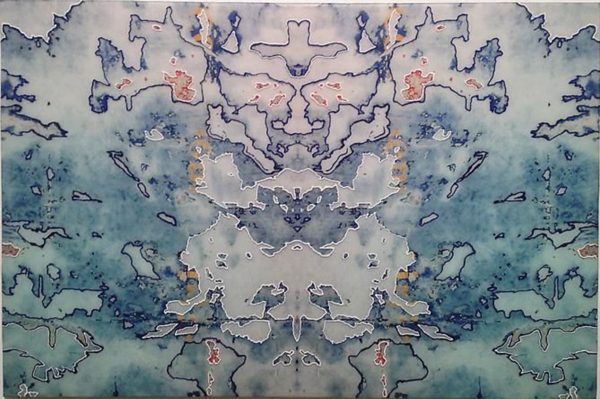
Nelson: Can you explain the process of creating these paintings, which involves fragmenting your actual photographs of these posters even further, and finally applying acrylic paint with a dental syringe?
Ivcevich: In some ways, I am merely a conduit in the creation of these works. I am making the decisions but the work is informing itself. Much of this is done in the computer. I use a couple different software programs to enhance colors, eliminate recognizable imagery and fonts. Sometimes the forms get duplicated and flipped to create Rorschach-like “mandalas” and sometimes singular forms are left alone. Raw canvas and linen areas in one series led to hand-dyed and screen printed backgrounds that give the images even more depth. It is quite a tedious practice when it comes to applying the paint. Layers of gesso are added only to the areas where I’ll be painting. A signature style element I’ve always used is relief achieved by applying the final layer of detail with syringes. For almost seventeen years, I did this through dental syringes. In researching alternative methods lately due to the physical stress it causes, I found a new pneumatic syringe. This is yet another development as the level of detail I can achieve will increase and I won’t suffer the pain caused by my previous method.
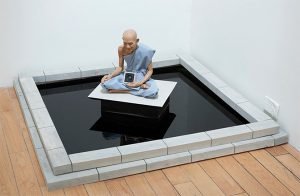
Nelson: The Shreds exhibition also features an installation of a monk sitting on a platform in a square pool of water holding a speaker that emits music. The paintings made from discarded advertisement posters hang above him. Can you comment on the symbolism of juxtaposing a Buddhist or Hindu monk with images of objects left behind from urban America?
Ivcevich: I’ve always felt like I was distilling the noise and chaos of the urban streets into something quiet, contemplative, and spiritual. A Zen-like approach to city life. When I started to flip the images into “mandalas,” the monks made perfect sense if perhaps a bit literal in the translation of the works. I’m a musician and love adding sound to exhibitions of work. The speakers the monks held played a seventy-minute looping soundtrack of field recordings from cities around the world, subway breaks and announcements, sirens, crowds, and chanting monks all blended with ambient tones processed through deep reverb. The sound and low lighting of the gallery created a calming, immersive experience when one walked into the gallery.
Nelson: How did growing up in in the industrial city of Indianapolis influence your artwork, particularly in such paintings as “Night Construct” and exhibitions such as Silhouette City and The Pastoral Paradox Reprise? These paintings reveal city scenes, often at night, with monstrous buildings, blurred flashing lights, and faceless people.
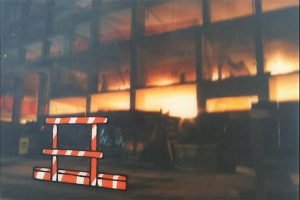
Ivcevich: I really don’t think of Indianapolis as that industrial. I grew up in the suburbs near city parks where I’d ride bikes through trails, under bridges, and along the river. I also was a camp counselor all through high school and college in Brown County, Indiana, near the Hoosier National Forrest among rolling hills, trees, caves, creeks, and rivers. It’s probably that experience and appreciation of the peaceful natural world that I am trying to reconcile with my life in cities. Being able to stop and recognize the sublime in a construction scene lit up at night or finding a bunch of blurred photos on my phone after a night out on the town is a gift informed by that background I suppose.
Nelson: At one time, you were a DJ and music producer. How has music influenced your artwork?
Ivcevich: Ain’t no “at one time” about it at all. Music is in my blood and will be for life. I actively spend as much time producing music as I do making art. The first thing I install in my art studio is the speakers. I never paint without music on in the background. I definitely feel like there is a rhythmic quality to my paintings, especially the “mandalas.” The music genres I mostly DJ and produce are firmly in the club/dance world (i.e. hip-hop, house, drum&bass, dub, etc…) and are based on repetition and rhythmic loops. The idea of taking a foundation groove and subtly expanding on that through additive or subtractive elements is very much the way I compose my art. For the curious ears reading this, check: J. Stroke on Mixcloud for DJ mixes, J. Stroke on SoundCloud and Ice Bitch on Bandcamp for original productions.
Nelson: What impact did traveling to such countries as Mali and Vietnam have on your artwork, particularly in such exhibitions as Field Recordings, Vol. 1 that feature an installation of a pile of discarded remotes, and paintings of nomadic Tuaregs?
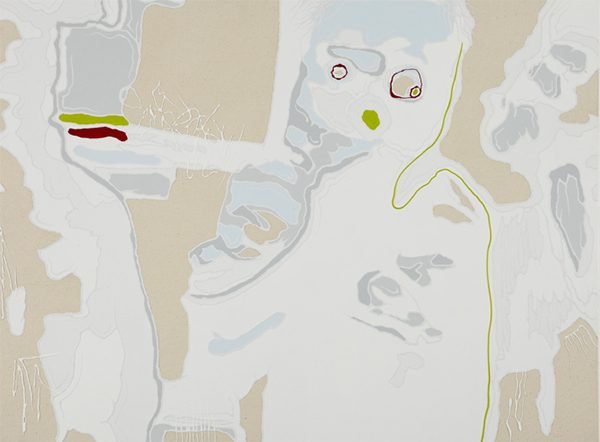
Ivcevich: Field Recordings, Vol. I was the last show I did with such straight illustrative and literal imagery. The show was expanding on the urban observation theme but obviously, in completely different settings. I was still focused on the overlooked and sublime to be found in the detritus of these places. I was always impressed with the resourcefulness of the people in both Vietnam and Mali. The cities were filled with repurposed consumer waste like piles of empty, plastic, gallon jugs. There was a sculptural aesthetic I appreciated but also I admired it even more coming from such a wasteful country like America. The trip to Mali was also a musical quest. My friends and I went to hear the music of West Africa in Africa. Our end goal was a music festival in the Sahara outside of Timbuktu but along the way, we experienced wonderful sounds and culture all the way up the Niger, into Dogon country and under the stars camping out alongside the Tuaregs and their camels. The trip was profound in many ways and I just felt compelled to document the experience.
Nelson: You are a self-taught artist. Can you explain how you learned how to create art, and the evolution of your artwork over the years?
Ivcevich: I have always had some inherent drive to make art work. I chose not to go to art school after high school (even though I was offered a scholarship) because I just wasn’t sure of my focus or skill level. I felt a broader-based education was more for me. I’m sure I missed out on a lot with that decision but I think it also led me to my particular style and approach to making work. In my post-collegiate years, I was DJing at night and working for a decorative house painting company during the day. I saved all the test color paints the clients didn’t want and used this to experiment in my basement. I’ve always frequented museums and galleries and took that inspiration home to see what I could contribute. Really, my work ethic (Eastern European immigrant roots), social connections, and a little luck helped develop my work. One opportunity led to the next and I quickly realized how my work needed to evolve. Since many of my early exhibitions were in smaller cities like Indianapolis and Atlanta, I was fortunate to see reviews in the local art press. This was my art education. The critiques I missed out on by not going to art school were in print. When I was awarded a Pollock-Krasner Grant, that was a pretty big stamp of approval for me and eventually led to my relocation to NYC thirteen years ago. In that time, I’ve constantly been in and out of all the galleries and museums here and actively think about how my work would fit in these environs. I use that fuel to fire my studio practice and the evolving work is a testament to that experience.
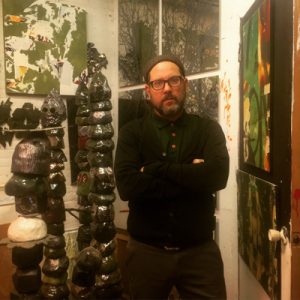
Nelson: How do you see your art developing in the future?
Ivcevich: I was blessed by some friends who gifted me a kiln two years ago and I’ve been pleased with the results. It is a small kiln so the works are limited in scale but I have been able to piece together good-sized works from smaller parts. I have some ideas about increasing the scale and incorporating 3-D ceramic printing technology. I am intrigued and excited by the dialogue emerging between these sculptural works and my paintings. I am also quite limited spatially in my studio. I would very much like to make some larger-scale work and I know exactly how I can produce this work. Obviously, I’d like more of this work out in the world and an engagement with a wider audience would translate into a larger budget that I can use to produce some of these concepts.
Nelson: Anything else you would like to add?
Ivcevich: I would just add a big thanks for taking the time and interest in reviewing my work. I know how many amazingly talented artists there are out there and how we’re all competing for the limited attention spans of our contemporary, Internet-addled, short-attention-spanned populace.
Copyright 2018 Woven Tale Press LLC. All Rights Reserved.

